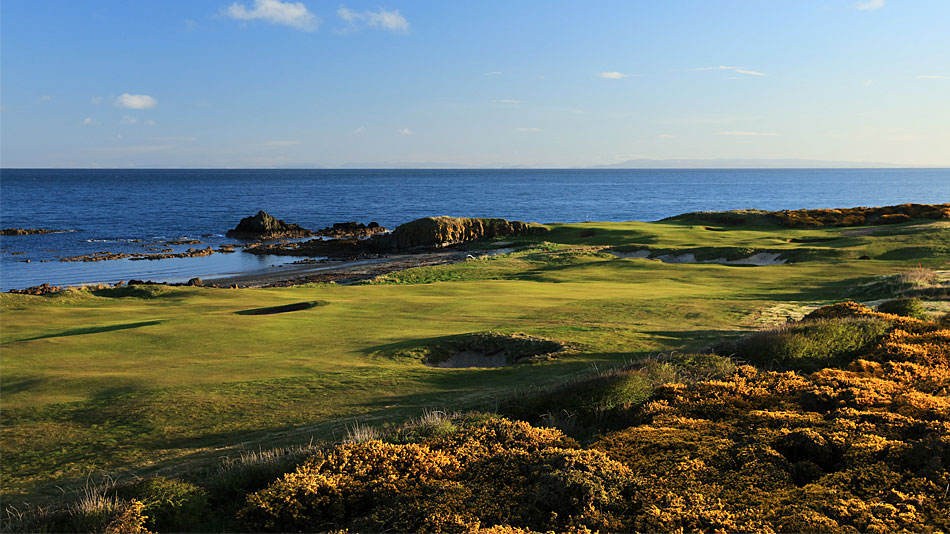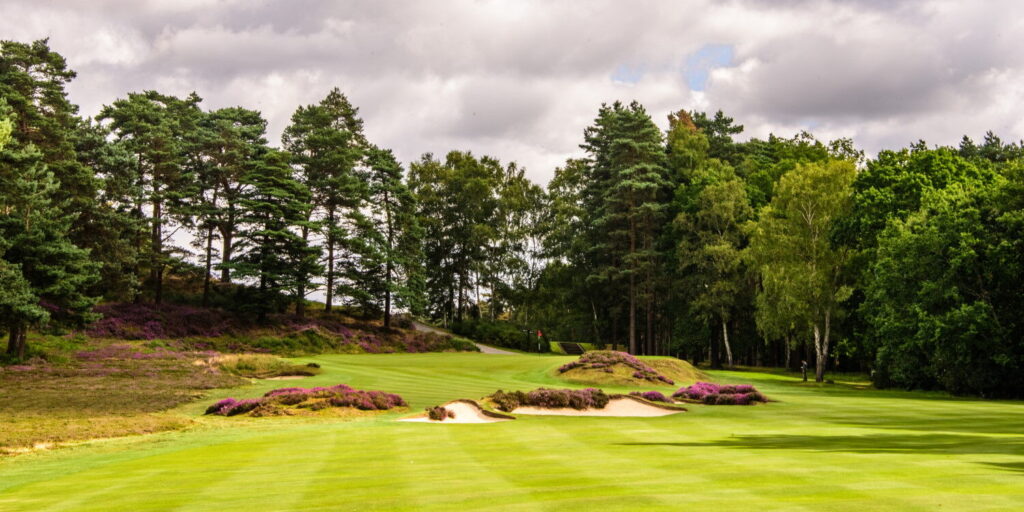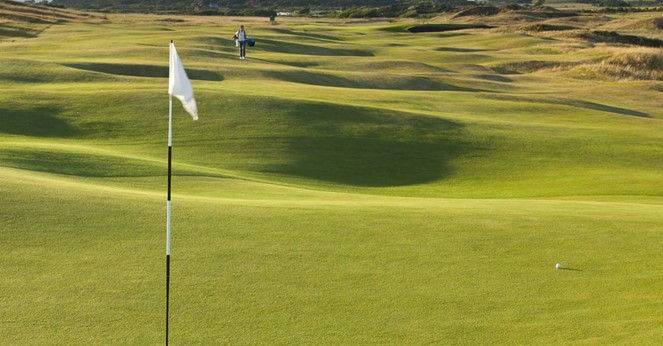@halfparkid (Peter) is a mysterious instagram character, who – like many – have built an anonymous social media presence around something he loves, able to share the finer details of bunkers, clubhouse lunches and green-to-tee transitions with a wider audience than just his school friends. Obsessed with British club culture and great architecture, we’ve been friends with Peter for a few years now and despite his diminutive frame, and bearing more than just a slight resemblance to the Superbad teenage tragic ‘McLovin’, there’s a huge golfing brain in there (as well as talent).
Peter played full time for several years, competing all over the world, and until recently was ranked 600th in the World Amateur Golf Rankings (WAGR). However, he now finds more enjoyment in the less competitive side of golf and the appreciation of the obscure. Here is his take on ‘half-par holes’…
–
Just before Christmas I was kindly invited to join Sam and Tom at the Prince’s Winter Invitational, a fantastic annual event hosted by Rob McGuirk and his team. Whilst much of the fun of this event is overconsumption and festive cheer, the other half is the course setup, where tees are pushed up to encourage heroic shots and birdies. Following a series of failed birdie attempts on the 6th (Shore), discussion turned to the topic of ‘half par’ holes, a conversation I am happy to indulge in and the inspiration behind my Instagram handle @halfparkid. Festivities moved to the Royal St George’s dormie and after another bottle of claret Sam suggested – as the “leading authority on the topic” – I should write an article to define what a half-par really is and why they are the secret sauce for great matchplay golf.
I’d love to sit here and write about the origins of half par holes, but the truth is they’ve always existed. The concept is simple – any hole seen as a good birdie chance or where a bogey isn’t a bad result would be a good definition, capped off with the need for thought and strategy to execute well. Variety is the spice of life and half pars are to great courses what coriander, cumin and cardamom are to a great curry.
Let’s not forget the term ‘par’ is a relatively recent addition in the games 500+ year evolution. The great classic Scottish courses were god-given and not built with the aim of holding players to account to an arbitrary number in the low 70’s. Matchplay was seen as the only real form of the game, and a ‘Bogey’ card was used more popularly for many years before the game went through a phase of standardisation at the turn of the 20th century where 18 holes (to many courses harm) became the accepted norm. Prestwick still to this date have a bogey card available for play and long may that continue!
‘Half-pars’ can be controversial like Hoylake’s first with its internal out-of-bounds skirting the right side where 5 will be an acceptable score for any player next July in the 151st Open Championship, or widely loved like the road hole at St Andrews, two of my favourite 4.5’s. As a rule, half par holes shine in matchplay golf where players are forced into decision making, where the taste of birdie or fear of bogey creates drama and momentum can shift. They can range from 2.5s (i’ll explain) to 5.5s, but all fundamentally require thought, precision and the strategy of the day is as much influenced by the state of the match as it is by your own game.
Typically, your 2.5s are very short par 3s with exceptionally small green sites. 3.5s can be either long par 3s where a long iron and 2 putts feels like a birdie or short and drivable par 4s that propel a round once taken advantage of. 4.5s again are both ‘short’ and ‘long’, either a short scorable par 5 or a long and brutal par 4, whilst 5.5s are rare and reserved only for the few remaining long par 5s that demand execution from start to finish.
It would be fair to assume my love for this school of golf course architecture has been inflated by regular matchplay golf at Deal, where we have between 6 and 10 half par holes depending on your tee of choice. Due to the large dispersion of our tee boxes, I regularly challenge my oppo to a game of ‘Ohoopee’, where the winner of the hole chooses the tee on the following hole to create endless variety and half par possibilities. Why play a par 4 from 390 yards when you can play it from 280 yards?
In truth, the two main catalysts for my appreciation of these holes were playing full-time golf and the annual Sunningdale Foursomes. The former was born out of a way to measure my performance throughout a round and actively seek out scoring opportunities. There was a time when I would see a 380-yard par 4 or a 550-yard par 5 as 3.5s and 4.5s respectively, but I think this obnoxious and subjective view overlooks the real beauty of the half par question. The bogey golfer will have a different opinion on what half par holes are compared to the scratch golfer, just like a good wedge player’s opinion will differ to the long drivers.
The Old Course at Sunningdale is the perfect canvas for matchplay golf, and in my opinion the best matchplay course in the UK. Playing the Sunningdale Foursomes moved world class half par holes out of my periphery and into sharp focus, with the 9th and 11th being classic examples, and perfectly timed within the round. Both short par 4s (260 yards and 310 yards respectively), they encourage long hitters to be greedy off the tee but penalise imperfect efforts with small greens and well positioned bunkers/ditches. The scratch player shouldn’t make 5, but a 3 can be guaranteed with a good drive, although this may only be good enough for a half. Coupled with a difficult long four into the half-way hut, this is the key stretch in any match played here.
Another example of a course flooded with half par holes is Blackwell, the home of the Cookie Jar. Upon leaving the wine cellar at the inaugural Blackwell Scratch Foursomes this year, high on red wine and conviviality, Sam and I concluded Blackwell was home to “at least” 11-half pars. Although some are subject of healthy debate, friends of Blackwell will agree that holes 3, 4, 5, 7, 8, 11, 12, 16 and 17 no doubt fit the criteria, leaving an exciting matchplay course regardless of which 9 you start on.
Berkshire Red and Gullane No.3 are also worthy of a mention for their abundance of half par holes, both arguably having more than 12 to their name. The ‘Red’ at The Berkshire breaks all the rules of course architecture with 6x 3’s, 6x 4’s and 6x 5’s, but this is simply a product of the variety of the holes themselves to create an exciting matchplay course where score variance is maximised and strategy is key, rather than some predetermined philosophy to ‘par’.
However, there’s only one course that can hold the crown as the ‘home of the half par’…
In a moment of over-excitement, I once proclaimed that the Old Course (my favourite in the world) might have 18 half par holes. Despite some admitted hyperbole on my part – holes 2, 8 and 15 certainly more regulation golf holes today – I think there is some validity here. In the annual match between Royal Cinque Ports versus University of St Andrews on Halloween this year where tradition insists birdieless rounds go punished with a ‘double barracuda’, I decided to put my theory to the test, seeking out as many birdies as possible. Following a lacklustre front nine, a steak and black pudding pie at the hut failed to lift my spirits (despite being the best halfway-house food I’ve had to date) I had resigned myself to a birdieless round on the Old Course, only to be saved by a 40-footer on the last in front of some over-excited tourists and my elated playing partners. Those same holes which had eluded me were on other times playing The Old ‘simple birdies’, and at other times were near impossible pars. The conditions, pin location and tee box create a myriad of possibilities and shift the strategy on any given day. If I ever needed proof that the Home of Golf was also home of the half par, then this was it. My mind, body and soul have never been more at one and the ‘Half Par Kid’ had never felt more alive
So why are half par holes the secret sauce to great matchplay golf?
Ultimately they present you with an opportunity to fail. A battle of nerve as you make a decision as to how you play the hole, one that can enable you to float to the next tee having gambled and won, or that can make you look a fool very quickly. Score variance gives us more possibilities, more outcomes, more drama and without doubt greater excitement as players.
Par is irrelevant, but that only makes half pars matter more.
Below is my half-par eclectic 18 with some light explanation:
Hole 1 – Woking (3.5) 270 yards, Honourable mention: Hoylake
Hoylake’s bunkerless and flat opener is a personal favourite, but what better way to start than with a warm handshake of a short par 4 in front of the clubhouse?

Hole 2 – Hollinwell (4.5) 460 yards,
Absolutely nails. You must be bold and daring with your second tee shot of the day if you want a good look at the green in two.

Hole 3 – Dumbarnie (3.5) 315 yards,
Maybe the best 3.5 I’ve played. A short downhill 4 that offers a safe layup or a heroic line to a funky green. A hole I could repeat a thousand times over and never bore of playing it.

Hole 4 – Rye (4.5) 440 yards, Honourable mentions: Pinehurst, Sunningdale New, Royal St. George’s, St Georges Hill.
The hardest hole I know perched upon Colt’s famous ridge – 4.5 may not even do it justice as it can play much tougher. Side note: it appears great 4th holes are common, and many of them are half pars.

Hole 5 – Porthcawl (4.5) 490 yards,
Reachable and down the prevailing wind, this three tiered stepped green played uphill gives you a huge scoring opportunity as well as plenty of peril if you get it wrong!

Hole 6 – West Sussex (3.5) 240 yards,
Once a par 4 and now a monster par 3 with an alternate route around the water for shorter hitters, how could I not include this gem?

Hole 7 – Georges (4.5) 510 yards, Honourable mentions: Gullane No.3.
I had to include George’s somewhere, and although 4 missed out to Rye I was happy to squeeze in the 7th. An underrated hole in my opinion that boasts lunar land movement and blind shots galore.

Hole 8 – Troon (2.5) 120 yards, Honourable mention: Renaissance & Blackwell.
2.5 is a despicable par to give any hole, especially one as demanding as the Postage Stamp, but it’s only a wedge and if you hit the green you leave a makeable birdie putt. A hill I’m willing to die on.

Hole 9 – Muirfield (5.5) 560 yards,
There are so many ways to embarrass yourself on this hole, and who doesn’t love a wall running the length of a hole?

Hole 10 – Turnberry (4.5) 500 yards, Honourable mention: Berkshire Red.
Whilst I’m not Turnberry’s biggest fan, this hole is marvellous. I wish the world could see how fantastic the 10th is and divert the undeserved attention away from the 9th

Hole 11 – Berkshire Red (3.5) 350 yards,
Downhill and majestic to look at. The 10th isn’t bad either!

Hole 12 – Sunningdale Old (4.5) 450 yards,
Visual deception and hidden bunkers make this two-shotter a great 4 if you can manage it.

Hole 13 – Prestwick (4.5) 460 yards, Honourable mention: Cleeve Hill
One of the best greens on the planet to cap off an already mental golf hole.

Hole 14 – Deal (3.5) 220 yards, Honourable mention: St Andrews Old.
In the words of Tron Carter “14 at St Andrews may be the only true 5 par remaining in golf”. I hope Tron won’t mind me extending Hell to a 5.5, whilst also subbing her out for the 14th at Deal. Afterall, I had to include the road hole and the lone par 3 on Deal’s back nine is a classic long one-shotter.

Hole 15 – Swinley (4.5) 500 yards, Honourable mention: Woodhall Spa
A 4 is essential on this beauty if you’re down in your match with only a few holes to turn the tide

Hole 16 – Portrush (3.5) 230 yards,
Take your four and run!

Hole 17 – St Andrews Old (4.5) 470 yards
Enough has been written about why this is the greatest hole in the world, so I have nothing to add.

Hole 18 – North Berwick (3.5) 270 yards, Honourable mention: TOC, Prestwick
Golf’s Harvey Specter: Charming, easing on the eye, and the best closer around. The world needs more 270-yard finishers.

And finally, some stretches of holes that are too good to be ignored:
Prestwick closing stretch 16-18
Maybe my favourite closing stretch for matchplay golf. 2 wildly different drivable par 4s bookending one of the worlds best holes, the Alps and its blind approach to an incredible green behind the Sahara bunker.
Sunningdale Old 9-12
3.5, 4.5, 3.5, 4.5. Incredible flow around four world class holes with a decent halfway hut in the middle.
Gullane No.3, the whole course
I dare anyone to play Gullane No.3 and not have the most fun they’ve ever had on a golf course.









